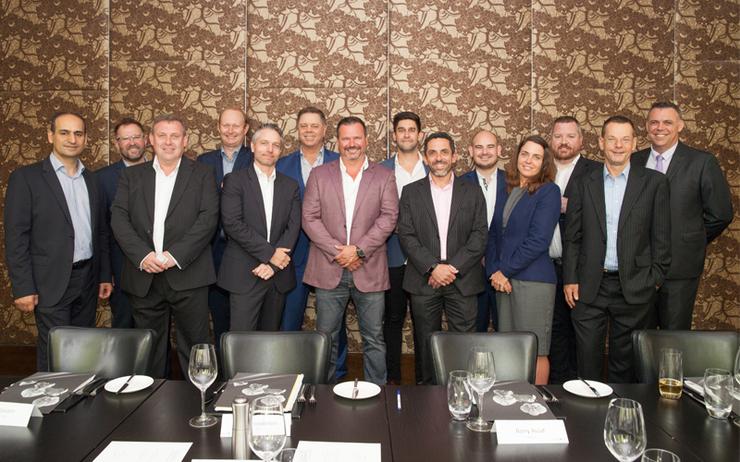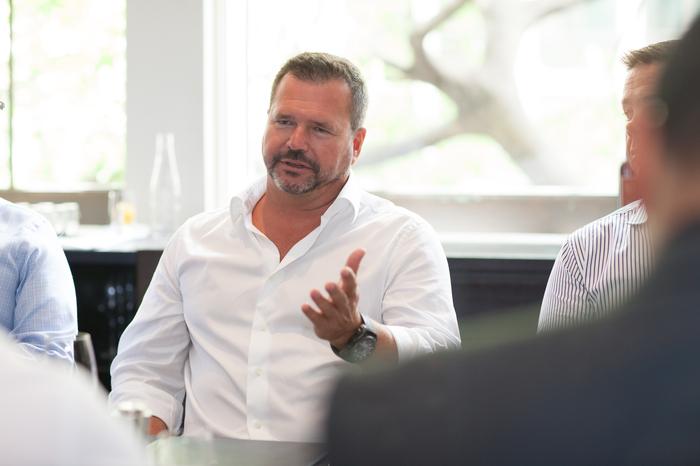
L-R - Barry Assaf (Nexon); Mike Morgan (Insight); Jim Stockwell (iasset.com); Eoin Coghlan (CCNA); Josh Watts (Harbour IT); Andy Hurt (NEC); Scott Frew (iasset.com); Dan Danielli (Arrow); Ronnie Altit (Insentra); James Henderson (ARN); Lucy Knowles (iasset.com); Nick Russell (Katana1); Cam Wayland (Channel Dynamics) and Richard Mitton (Atlas Plato)
“This can completely leave my business exposed because this function isn’t always managed by the partner.
"Because of this, the business of our customer could fall over due to an end-of-life on a server or storage solution. This might not be our fault but either way, you are held responsible as a partner.”
Despite a clear indication that challenges occur, the majority of partners are not able to reinvent business processes with any sense of urgency.
“It’s always difficult to integrate new technologies because expense is the biggest challenge,” Nexon managing director, Barry Assaf, said. “How the business adapts to this change is crucial because if you utilise a new platform, how will your organisation react?
“We have our own tools internally but if we were to utilise a new offering in the market, this would require us to cross-train people which is expensive and time consuming. The main issue is that we don’t have an internal IT team and that all of our focus is on the customer and delivering an outcome.”
Running complex business functions through manual processes is not consigned to smaller market players however, with organisations of all shapes and sizes hamstrung by a lack of internal automation.
“We’re dealing with multiple vendors and each one deploys different systems, which are changed constantly,” Insight vice president and managing director of Asia Pacific, Mike Morgan, added. “We’re throwing more and more people at our operations team but now we’re realising that this might not be the best practice.
“In our industry, prices and margins are not going up so the only place to look for efficiencies is in-house. But if we keep throwing people at problems we will struggle to resolve anything.
“Most businesses see operational change as a big box that they would rather not open. Because once it’s opened the problem pulls other parts of the business into the mix and before you realise, the situation turns into a program of work.
“It’s much easier to throw your support behind an idea that is tangible, quick and has return on investment unlike a potential Pandora’s Box scenario.”
Illustrating a wider issue spanning the entire channel spectrum, partners remain blocked by a failure to maintain an effective balance between running legacy systems with utilising innovative technologies.

“We have the same challenges,” Optus head of ICT, Mike Kearney, added. “Businesses also now have the added complexity of not only stepping into a complex environment, but taking on management of cloud subscriptions in addition to licensing and maintenance.
“The reality is that if your business is not heading towards automation and if you haven’t carved out a part of your workforce to deal with that, then you could face problems in the near future.”
Looking outwards, challenges also arise when managing customer environments, with a lack of visibility preventing partners from fully understanding end-user systems and therefore the risks associated.
“The hardest challenge we face is understanding where a business is at today, never mind where they want to go in the future,” NEC Australia director of sales and solutions, Andy Hurt, added. “As an MSP, we’re not taking over a blank sheet of paper, customer operations are already established and well entrenched.
“But we need to carry out an audit to assess the risk, renewals and complexities and determining that risk is one of our hardest challenges. We analyse the risk to our business when taking on large managed services contracts but it can be difficult to understand the customer environment.
“It’s a complex and manual exercise and we need tools to help us through this process. It’s yesterday’s technology doing tomorrow’s work.”
Automation
As Australia advances at pace towards a digital future, the channel must maintain market momentum alongside, through the modernisation of systems and processes.
No longer can a partner be weighed down by legacy, yet still expect to compete.
“New partners are smaller and are not burned by legacy,” Channel Dynamics director, Cam Wayland, said. “They can adopt a whole range of new tools and platforms and become more automated.
“Partners operating across the mid-market are feeling this pain more than most because they know they need to automate, but it’s a painful process. They know change is required but they don’t have the resources to focus on themselves and make the change.

“It’s getting to the point that the more successful a partner becomes the bigger the problem is as they don’t have time to work in the business.”
According to Wayland, change is predominantly being driven at boardroom level across partner organisations, led by a realisation by senior management that operations can be drastically improved through automation.
“We are making big bets over the next 6-12 months to focus on the back-end of our business,” Harbour IT COO, Josh Watts, added. “But this change needs to be driven from the top down.”
In practice, the common view from partners is that consolidating multiple processes represents a complex undertaking, creating business headaches and long-lasting issues.
But low hanging fruit does exist in the form of a range of quick-fire wins.
“Efficiencies within the channel can be applied in multiple ways,” iasset.com CEO, Scott Frew, outlined. “If you take renewals as an example, on average, it takes 22 steps and more than eight independent systems to process a renewal quote the traditional way.
“Or take cloud contracts. Many vendors still rely on manually populating spreadsheets to calculate usage and process their monthly Billings.
Considering the vast amounts of data cloud consumption brings, this can be a recipe for disaster.”
Launched in 2009, iasset.com was created to address the inefficiencies of the renewals process of Distribution Central, increasing the distributor’s renewal rate from 40 per cent to 90 per cent within six months.
In 2018, iasset.com continues to evolve, through designing advanced cloud engines to drive channel efficiencies, serving a global customer base and managing over $10 billion in assets in the process.




